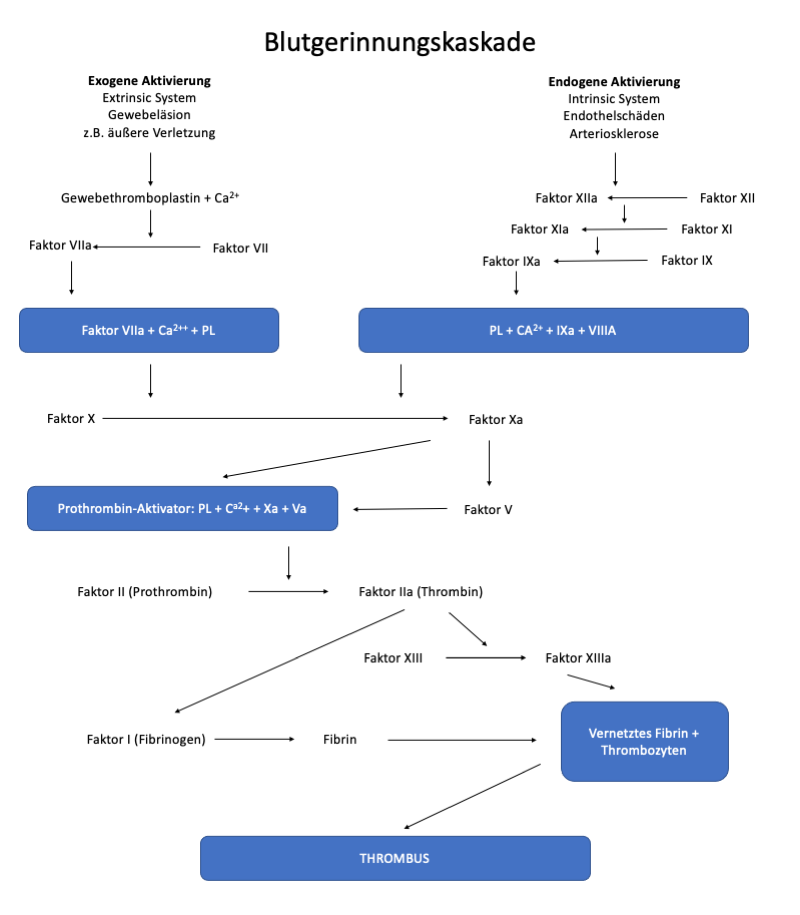Coagulation System
The arrest of bleeding, also called blood clotting or hemostasis, is the ability of blood to provide closure to a wound.
blood taken from blood vessels "coagulates" spontaneously within a few minutes in the test tube. During this process, the blood changes from a liquid state to a gelatinous state with the participation of formed elements. The property of blood to clot outside the vascular system is an extremely vital process, the importance of which lies in protecting the body from losing its blood fluid. Blood clotting has several phases
1st phase: vascular constriction
The blood vessel contracts. This is caused by humorale factors together with neuronal reflexes and locally triggered spasm of the vessel. The vessel closes as far as it can. Now platelets can cluster here.
2nd phase: Primary hemostasis by platelet aggregation
Initially, a wound plug is created solely from the platelets present in the blood:
Dazu werden sie durch wandständige Kollagenfasern, die in den Verletzungsbereich hineinragen, aktiviert. Die Aktivierung bedeutet, dass sie größer werden, dass sich aus ihrer Wand Ausläufer entwickeln und dass sie sich mit Hilfe einer Art Kleber an die Kollagenfasern anheften. Dabei aktivieren sie wiederum andere nahe Thrombozyten und entwickeln so einen Thrombozytenpropf, den sogenannte Primärthrombus.
The final strength of the closure plug is achieved by the contraction of the platelets, which are "felted" with their pseudopodia and fibrin threads.
This process, which normally takes 5 - 7 minutes (coagulation time), involves platelets as well as a large number of plasmatic factors.
The actual coagulation process - like primary haemostasis - is triggered by the vessel and tissue injury and activated in two different ways:
- exogenous or extravascular way (Extrinsic System)
- endogenous or intravascular way (Intrinsic System)
On the exogenous path, activation takes place very quickly (within seconds), while on the endogenous path, activation takes place over a larger number of intermediate stages and takes longer (minutes). As a rule, both systems are involved in the normal coagulation process. The common final stage of the two activating systems finally makes prothrombin (factor II) and vitamin K formed in the liver is converted into thrombin. The thrombin thus formed is an enzyme, which also synthesizes the fibrinogen (factor I) and thus initiates the formation of fibrin.
Gerinnungskaskade
Der eigentliche Gerinnungsprozess wird - wie die primäre Hämostase - durch die Gefäß- und Gewebsverletzung ausgelöst und auf zwei verschiedenen Wegen aktiviert:
- exogener oder extravaskulärer Weg (Extrinsic-System) - bei Gewebsverletzungen, schnelle Reaktion
- endogener oder intravasaler Weg (Intrinsic-System) - bei Verletzungen im Gefäß selbst, zum Beispiel Endothelveränderungen (Entzündungen, Arteriosklerose), langsame Reaktion
Auf dem exogenen Weg erfolgt die Aktivierung also sehr schnell (innerhalb von Sekunden), während der Aktivierungsprozess auf dem endogenen Weg über eine größere Zahl von Zwischenstufen abläuft und längere Zeit (Minuten) benötigt. An dem normalen Gerinnungsablauf sind in der Regel beide Systeme ineinandergreifend beteiligt. Durch die gemeinsame Endstufe der beiden aktivierenden Systeme wird schließlich Prothrombin (Faktor II) und unter Mitwirkung von Vitamin K das in der Leber gebildet wird, in Thrombin umgewandelt. Das so entstandene Thrombin ist ein Enzym, welches das gleichfalls in der Leber synthetisierte Fibrinogen (Faktor I) spaltet und damit die Bildung von Fibrin einleitet.
Die Gerinnungskaskade sieht graphisch folgendermaßen aus:
Weitere Informationen:

